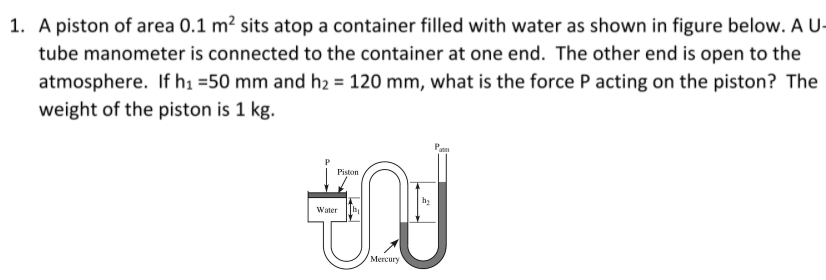kindly help me with this problem I provide some information for the solution needed.
Use free floating decimals in all your calculations and in expressing your final answers.
• Solve problem SYSTEMATICALLY and NEATLY thank you!

Extracted text: 1. A piston of area 0.1 m² sits atop a container filled with water as shown in figure below. A U- tube manometer is connected to the container at one end. The other end is open to the atmosphere. If h1 =50 mm and h2 = 120 mm, what is the force P acting on the piston? The weight of the piston is 1 kg. Piston Water Mercury
![A U-tube manometer is shown in the Figure above. The pressure P, is exerted on<br>one arm of the U-tube and P, on the other arm. Both pressures P, and P, could<br>1.<br>Differential Manometer (Multiplying Gauge)<br>In this device, the end of a U-tube are connected<br>to two enlarge chambers. The manometer<br>contains two liquids B and C which are immiscible ,<br>and whose densities are as nearly egual as<br>possible. The closer the densities of the two<br>liquids, the more sensitive is the manometer.<br>be pressure taps from a fluid meter, or P, could be a pressure tap and P, the<br>atmospheric pressure. The top of the manometer is filled with liquid B, having a<br>density of p.and the bottom with a more dense fluid A, having a density of e,.<br>PB<br>Liquid A is immiscible with B. Derive the relationship between P, and P,.<br>Using point 2 and point 3 as our reference since both points lie on the same liquid<br>level<br>(b)<br>P = P,<br>P. + Pg (Z+R)= P, + Pg<br>g.<br>P.- P, = (R-Ro) [ pa – po + (a/A) ps – (a/A) pc ]<br>g.<br>P. - P, = P. Z+ P. R- P, 3 (Z + R)<br>ge<br>ge<br>Where: R= actual reading<br>ge<br>Ro = reading when Pa = P.<br>P. - P, = PA<br>8 R- PB<br>g.<br>ge<br>Derivation of Inclined Manometer Equation:<br>b. Inclined Manometer - this is often used for the measurement of small<br>opposite side Rm<br>Rm = R1sin a<br>R1<br>sin a =<br>pressure differentials accurately.<br>Used to measure very small pressure differences or changes<br>It is slant manometer. The angle of measuring leg is usually about 10°.<br>• Inclination is done to improve the sensitivity.<br>It measures more accurately than the vertical tube type manometer.<br>һуpotenuse<br>P1 = P2<br>Pa + Pa<br>OB2)Rm = Pg + PA<br>Rm<br>PA + Pa2)R1sin a = Pg + Pa<br>R, sin a<br>Pressure<br>Pressure<br>PA - Pg = PA<br>(2)R, sin a- pe<br>Po()R,sin a<br>P.<br>P.<br>INCLINED MANOMETER<br>PA - Pg = (Pa – PB)2)R15<br>sin a<br>EQUATION<br>opposite side Rm<br>sin a =<br>hypotenuse<br>R1<br>](https://s3.us-east-1.amazonaws.com/storage.unifolks.com/qimg-008/008_w70uzz0-uopnsm0o.png)
Extracted text: A U-tube manometer is shown in the Figure above. The pressure P, is exerted on one arm of the U-tube and P, on the other arm. Both pressures P, and P, could 1. Differential Manometer (Multiplying Gauge) In this device, the end of a U-tube are connected to two enlarge chambers. The manometer contains two liquids B and C which are immiscible , and whose densities are as nearly egual as possible. The closer the densities of the two liquids, the more sensitive is the manometer. be pressure taps from a fluid meter, or P, could be a pressure tap and P, the atmospheric pressure. The top of the manometer is filled with liquid B, having a density of p.and the bottom with a more dense fluid A, having a density of e,. PB Liquid A is immiscible with B. Derive the relationship between P, and P,. Using point 2 and point 3 as our reference since both points lie on the same liquid level (b) P = P, P. + Pg (Z+R)= P, + Pg g. P.- P, = (R-Ro) [ pa – po + (a/A) ps – (a/A) pc ] g. P. - P, = P. Z+ P. R- P, 3 (Z + R) ge ge Where: R= actual reading ge Ro = reading when Pa = P. P. - P, = PA 8 R- PB g. ge Derivation of Inclined Manometer Equation: b. Inclined Manometer - this is often used for the measurement of small opposite side Rm Rm = R1sin a R1 sin a = pressure differentials accurately. Used to measure very small pressure differences or changes It is slant manometer. The angle of measuring leg is usually about 10°. • Inclination is done to improve the sensitivity. It measures more accurately than the vertical tube type manometer. һуpotenuse P1 = P2 Pa + Pa OB2)Rm = Pg + PA Rm PA + Pa2)R1sin a = Pg + Pa R, sin a Pressure Pressure PA - Pg = PA (2)R, sin a- pe Po()R,sin a P. P. INCLINED MANOMETER PA - Pg = (Pa – PB)2)R15 sin a EQUATION opposite side Rm sin a = hypotenuse R1